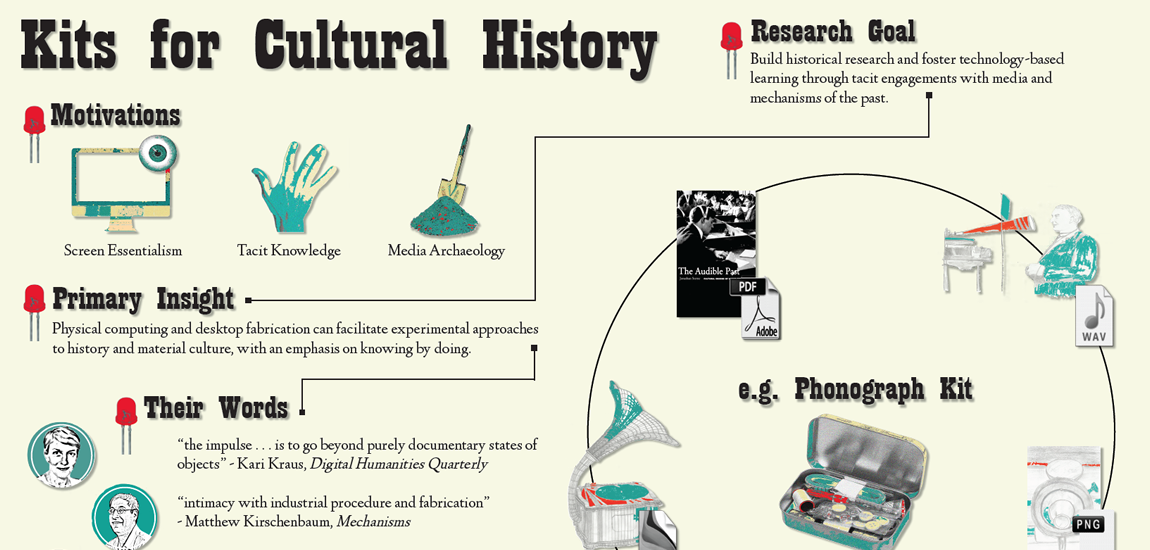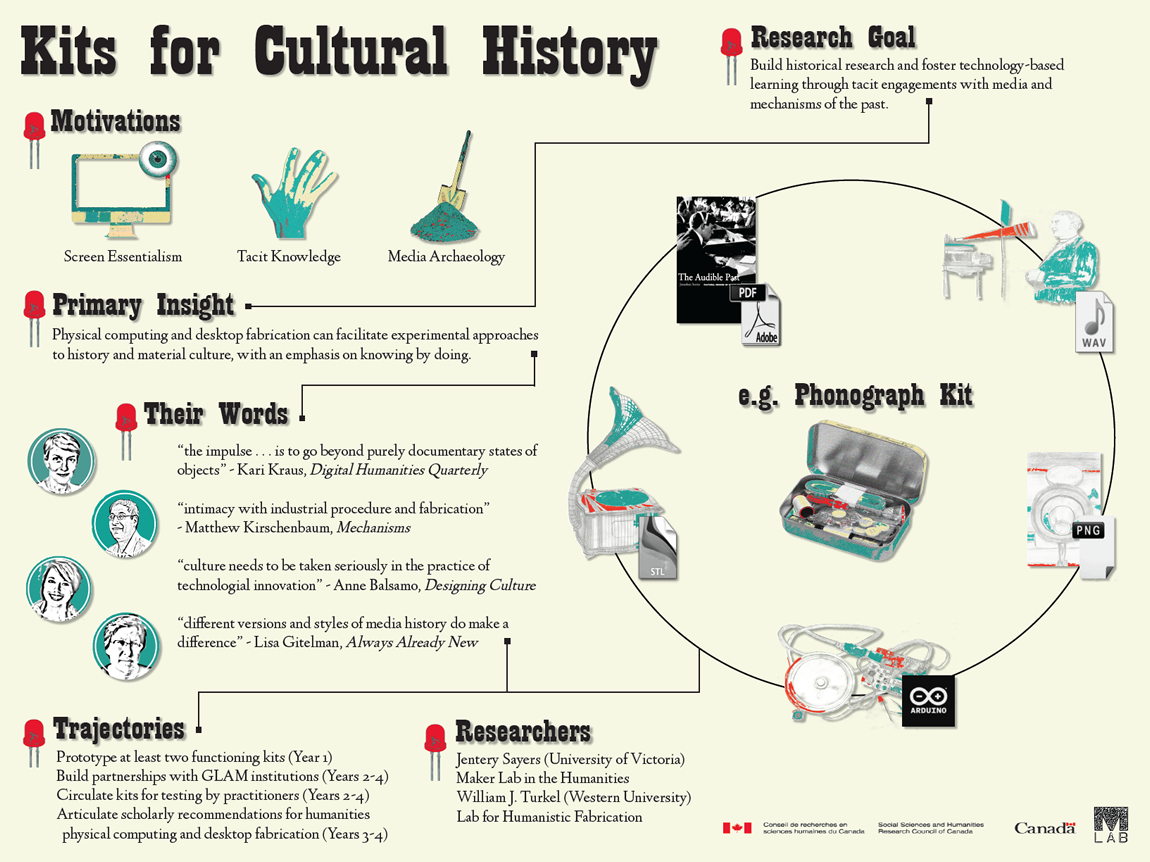At the CSDH/SCHN conference this year, Nina Belojevic and I exhibited a poster highlighting the early stages of the Lab’s new “Kits for Cultural History” project, conducted in collaboration with Bill Turkel and the Lab for Humanistic Fabrication at Western University. Soon, we’ll publish an overview of the Kits project here at maker.uvic.ca. For now, we’re sharing some brief details, together with a low-resolution version of our CSDH/SCHN poster:
The poster walks audiences through the general motivations, primary goal, and key trajectories of the Kits project, anchoring it all in a prototype. In short, “Kits for Cultural History” responds to three primary threads of research in media and technology studies. In conversation with scholarship by Wendy Chun, Wolfgang Ernst, Matthew Fuller, Lisa Gitelman, Matthew Kirschenbaum, Kari Kraus, and Nick Montfort, it asks how histories of electronic media and technologies might avoid reducing their dynamics to what is ultimately expressed (as a “re-source”) on our computer screens. Put this way, the proposed kits correspond with ongoing research in platform studies, computational culture studies, and media archaeology, asking scholars to shift their attention away from screens and toward the cultural and material particulars of transduction, compiling, inscription, playback, and—more generally—making and use. This emphasis on materiality is embedded in tacit knowledge production, looking to work by Anne Balsamo, Tara McPherson, Shannon Mattern, Tara Rodgers, Giles Slade, and Jonathan Sterne (among others) for our methodological framework. An important impulse of this framework is developing humanities physical computing and desktop fabrication, which—at least in digital humanities—are typically ignored or overlooked. Not only will the Kits project allow us to foster a research climate for humanities physical computing and desktop fabrication (including research training for graduate students in humanities labs at Victoria and Western). It will also allow us to produce builds for and by researchers invested in materialist history and material culture.
During CSDH/SCHN, a frequent question about our poster was what, exactly, the kits will look like. What will they do? How will they function? What’s the recipe? As the “Research Goal,” “Primary Insight,” and “Trajectories” sections of the poster suggest, the kits will in fact be physical objects, held in hand and unpacked much like, say, sewing kits or electronics kits. The phonograph kit we use as an example does what it can to (for now) exhibit these affordances. A given kit might include PDF or print snippets of scholarship (e.g., from Science and Technology Studies), old media (e.g., phonograph recordings in WAV and digitized images from patents and magazines), fabricated component parts of historical technologies (e.g., a phonograph transducer), interactive objects (e.g., an Arduino microcontroller and speaker circuit), source code (e.g., STL files, G-code, and Processing sketches), and a physical container or box, the model and makeup of which will also be open-source. The containers will reflect packaging aesthetics appropriate for their historical context, and—electronics and related hardware aside—all kit components will be downloadable. But, perhaps more appropriate for the look and feel of the Kits project, they could also be compiled and sent by snail mail.
The idea, then, is to give people opportunities to engage the cultural histories of media and technologies hands-on by steeping materials in context and—wherever possible—lowering the barrier of entry to learning about computing, media, and technologies (especially for people who are unfamiliar with them). In so doing, we will be collaborating with galleries, libraries, archives, and museums (in Canada and beyond) and articulating best practices for humanities physical computing and fabrication. For inspiration throughout this process, we’ll be looking to groups like Fluxus and their Fluxkits, which Alison Knowles recently described during “Thing/Thought” at MoMA:
We are still in the process of selecting the case studies and curiosities for our kits, which will likely include examples from the histories of audio, photography, film, print, fibers, computing, and gaming. If you have suggestions, or you would like to work with us on a kit, then please get in touch. Again, very soon we’ll publish more about the “Kits for Cultural History” project here at maker.uvic.ca. Thank you for your patience.
If you are interested in acquiring a high-resolution version of our CSDH/SCHN poster for research or educational use, then please do not hesitate to contact us. You can also use the PDF version for such purposes, if you wish. Nina Belojevic, Jon Johnson (UVic English), and I made the poster in May 2013 using InDesign CS6. As with everything at maker.uvic.ca, it is covered by a CC BY-SA license. A big heap of thanks to Nina and Jon for their help in pulling the poster and its presentation together, and to Alex Christie and Shaun Macpherson for their feedback along the way.
Post by Jentery Sayers, attached to the Makerspace and KitsForCulture projects, with the fabrication and physcomp tags. Featured image for this post care of Nina Belojevic, Jon Johnson, and Jentery Sayers.



Pingback: Conversations with collections | discontents()
Pingback: Maker Lab in the Humanities » University of Victoria » New Poster: Humanities on the Z-Axis()
Pingback: Maker Lab in the Humanities » University of Victoria » Thinking through Infrastructure()
Pingback: Maker Lab in the Humanities » University of Victoria » Digging into Tennis for Two()
Pingback: Editors’ Choice: Podcast: Jentery Sayers on Remaking the Past | Digital Humanities Now()
Pingback: Research & Scholarship » Blog Archive » Reflecting on Networks()